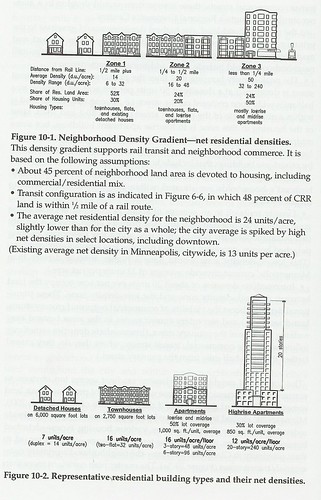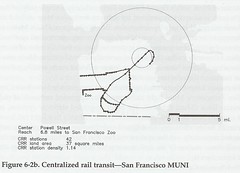I'm embarrassed...

Population density necessary to support successful transit (Belmont).
that I missed this piece by Roger Lewis in the Washington Post, "Lessons of Arlington's Urban Development Needn't Be Just History," which is discussed in The Overhead Wire. (Reading Roger Lewis' columns for 20 years has been part of my urban design education.)
However, Roger doesn't explain it as I would have exactly, focusing on urban design, population intensity, the ability to add new buildings (Arlington has been able to build more intensively than DC, which is mostly built out + we have the height limit), and the need for station density.
Professionals criticize the DC WMATA system* because it is "polycentric," focused on moving commuters living far out of the city into the downtown.

Polycentric WMATA subway system (from Belmont).
However, there are two exceptions to the problems of polycentricism normally posed by the WMATA subway system in the Washington region:
1. At the core of DC, there are 29 stations in about a 15 square mile area, providing a kind of "monocentric" transit network within the polycentric network. (This functions in a fashion similarly to that of the San Francisco within-the-city MUNI system vis-a-vis the BART system which moves the commuters into the city.)
2. And in Arlington County, rather than focus on commuters by building the Arlington portion of the orange line on I-66, they decided to focus transit within the County, by building it under Wilson Boulevard.
It ends up being a much different focus on transit within a place, not just to and from a place, in terms of the long term effects on land use and mode shift.
But it takes a long time to see the results. In both DC and Arlington County, it has taken 20+ years. Even so, you can see the vital experience of urban design and scale in terms of leveraging transit. Crystal City and Rosslyn are gross. And Wilson Blvd. could be better. I'd take Connecticut Avenue NW any day over those places (well, excluding Van Ness).
Note that as Roger points out that Bethesda needed to have more subway stations in order to better leverage transit, Arlington has four stations in just under 2 miles, the distance from Courthouse Metro to Ballston Metro.

MUNI station density in San Francisco (Belmont).
Anyway, the book that I think is the best book in planning since Death and Life of Great American Cities is Steve Belmont's Cities in Full, published by the American Planning Association, and he discusses the necessity of recentralizing commerce, housing, and transit.
Note that if the separated blue line is to be built to add capacity and redundancy at the core of the city, that would add 7 stations to that 15 square mile area, providing a subway station density of 2.4/square mile.

2001 graphic from the Washington Post on proposed changes for the WMATA system.
* Note that the other place where DC (and the region) lucked out is that the Washington region built a subway _system_ whereas most other next generation transit systems from the 1960s/1970s/1980s built one or two lines.
Just like you need station density within a place, you need a dense transit network, in order to have positive scalar effects from transit.
Labels: sustainable land use and resource planning, transportation planning



0 Comments:
Post a Comment
<< Home